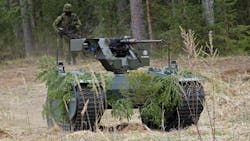U.S. military shifting research and technology development toward armed robotic ground vehicles
THE MIL & AERO COMMENTARY – Support for unmanned combat vehicles on the ground, such as autonomous armored personnel carriers, military utility vehicles, and even main battle tanks, is gaining momentum, as Pentagon leaders shed light on a potential future for robotic vehicles taking a lead role in ground combat.
In less than a year the U.S. Army will begin field tests of autonomous M2 Bradley Fighting Vehicles under realistic conditions at Fort Carson, Colo. -- home to several mechanized infantry brigades where solders are used to fighting with and alongside of armored combat vehicles.
For these exercises at Fort Carson, the Army will use autonomous Bradley vehicles called Mission Enabler Technologies-Demonstrators (MET-Ds). Outcomes of these field tests will help guide future Army autonomous combat vehicle projects and policies.
Perhaps just as important, the Army last June revealed plans to develop an armed unmanned ground vehicle (UGV) with onboard 20-to-50-millimeter automatic cannon that could fight alongside infantry and destroy enemy armored personnel carriers, trucks, and troops.
To kick off This Robotic Combat Vehicle-Medium (RCV-M) project, the Army Ground Vehicle Systems Center (GVSC) in Warren, Mich., is planning to issue a call for industry white papers, perhaps in the next few months.
The RCV-M will be an attritable unmanned platform to augment infantry with direct-fire capability and on-board sensors, with a common chassis and tailorable modular mission payloads. These kinds of armed unmanned ground vehicles should be able to keep pace with infantry and other armored vehicles during off-road maneuver and movement on paved streets and highways.
In April 2018 the Army Tank Automotive Research Development and Engineering Center (TARDEC) in Warren, Mich., through the Army Contracting Command at Picatinny Arsenal, N.J., announced plans to issue a request for prototype proposals (RPP) for the Combat Vehicle Robotics (CoVeR) program.
The Army's CoVeR program seeks to develop autonomous vehicle mobility technologies to enable military tracked autonomous vehicles to operate in tough military environments at realistic speeds.
Related: Remote combat vehicles to punch as hard as Abrams tanks
CoVeR is an outgrowth of the Army's Wingman Joint Capability Test Demonstration, which applies autonomous technologies to Army unmanned Humvee wheeled combat vehicles. The CoVeR project's ultimate goal is to enable soldiers of the future to team up with new kinds of robotic battlefield vehicles that will allow for increased stand-off between themselves and enemy forces.
These projects represent an evolving shift in U.S. military towards unmanned ground vehicles fitted with weapons, rather than just unarmed vehicles for applications like bomb search and disposal, logistics and supply, reconnaissance, and covert intelligence gathering.
One of the latest military projects involving unarmed robotic ground vehicles is a U.S. Marine Corps initiative launched late last year to explore an unmanned ground vehicle (UGV) to carry extra ammunition, packs, food, and water for infantry squads.
This effort follows an Army initiative to select an unmanned squad vehicle that can partner with infantrymen to lighten their loads. The Marines are trying to define what it will take to prototype and deliver such an unmanned vehicle that can maneuver with a foot-mobile squad of 12 Marines from the assembly area to forward combat areas.
There was a time not long ago when talk of arming unmanned vehicles in the air, on the ground, and in the ocean, was almost forbidden. The firm belief was that a human in the chain of command must be in the loop before any weapons are released.
As sophistication of unmanned vehicles increases, however, attitudes are changing about armed unmanned vehicles. It was only a matter of time.
There's a growing aversion in the U.S. military to put human infantry soldiers, combat aircraft pilots, and sailors in harm's way. This is understandable in light of the last century of human conflict that saw some of the worst battlefield horrors on the Western Front in World War I, cave warfare in Iwo Jima during World War II, hidden tunnels and booby traps of Vietnam, and the improvised explosive devices (IEDs) in Southwest Asia today.
I supposed it's inevitable that armed unmanned vehicles will become a big part of U.S. military forces over the next few decades. Top commanders should consider potential unintended consequences of automating front-line fighting forces. Once it starts in earnest, there's little chance of turning back.

John Keller | Editor-in-Chief
John Keller is the Editor-in-Chief, Military & Aerospace Electronics Magazine--provides extensive coverage and analysis of enabling electronics and optoelectronic technologies in military, space and commercial aviation applications. John has been a member of the Military & Aerospace Electronics staff since 1989 and chief editor since 1995.

